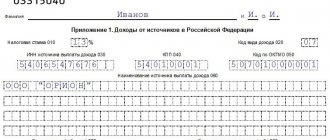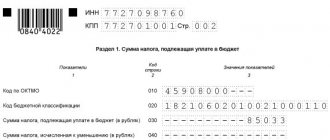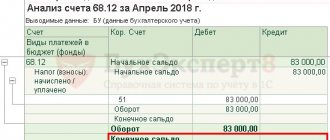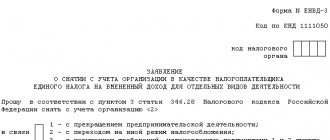The declaration was approved by order of the Federal Tax Service No. ММВ-7-3/[email protected] dated February 26, 2016. The order came into force on April 10, 2021, so some individual entrepreneurs could already submit a declaration using the new form for 2015, although they were not required to do so .
The rules for filling out a declaration under the simplified tax system with the taxable object “Income reduced by the amount of expenses) have not changed, so when filling out you can use last year’s article “STS: how to fill out a declaration for 2015.”
General information about the declaration
The declaration consists of six sections and a title page.
There are different sections for different taxation objects of the simplified tax system: for the simplified tax system with the object “income” sections 1.1, 2.1.1 and 2.1.2, for the simplified tax system with the object “income minus expenses” sections 1.2 and 2.2. Section 3 and the title page are common to both types of simplified taxation system. Section 3 is presented only to those taxpayers who received targeted financing funds that are not taxed under the simplified tax system. Those. Usually commercial organizations and individual entrepreneurs do not have this section as part of the declaration, so it is not discussed in the article. Sections 1.1 and 2.1.1 are mandatory for all “simplified” users with the “Income” object; section 2.1.2 is completed only by trade tax payers. The presence of a separate section for them is due to the fact that it is only possible to reduce the tax on income from activities subject to the trade tax. Those. if an organization (IP) has activities that are not subject to trade tax, income from them is not included in section 2.1.2.
It should be taken into account that the tax under the simplified tax system can be reduced on a trade fee only for organizations and individual entrepreneurs registered in Moscow, since only in this case the tax is paid to the same budget as the fee itself.
All rules for filling out the declaration are set out in the Filling Out Procedure, which can be found on our website in the Forms section.
Note!
The declaration indicates only the accrued tax amounts, the paid amounts are not indicated; the tax inspectorate already has data on payments.
Deadlines for paying taxes and filing returns
Tax is paid in advance for each reporting period no later than the 25th day of the month following its end. Tax reporting periods under the simplified tax system are the first quarter , half a year and 9 months . Thus, the taxpayer makes three advance payments during the year.
The tax period for tax under the simplified tax system is a year . When it ends, taxpayers recalculate the tax amount. The difference between the tax payable and the amount of advances actually transferred must be paid within the following terms:
- organizations - no later than March 31 of the following year;
- entrepreneurs - no later than April 30 of the following year.
Important nuance! For payers of the simplified tax system with the object “income minus expenses,” there is a minimum tax amount. It is equal to 1% of the amount of income received during the tax period . This is exactly the amount that must be paid to the budget if at the end of the year the tax is calculated in a smaller amount.
The simplified tax system is applied voluntarily, but has limits on the number of employees, income and some other indicators. If these limits are exceeded, the subject loses the right to apply the simplified tax system . In this case, you must report for the period worked in the year by submitting a declaration no later than the 25th day of the month following the loss of the right to the special regime.
The same reporting date is provided for cases of termination of activities in respect of which the simplified tax system was applied . The declaration must be submitted no later than the 25th day of the month following the one in which the activity was terminated.
You can find out about other important reporting dates in our tax calendar.
General rules for filling out the declaration
The declaration can be submitted either on paper or electronically via telecommunication systems.
When submitting a declaration on paper, it is better to use machine-readable forms. There is no obligation to use them specifically, but an attempt to submit declarations filled out on other forms may fail - the tax office will simply refuse to accept it and you will have to defend your right to use ordinary forms with a scandal. Machine-oriented forms with a two-dimensional barcode can be generated using special software, including free software (Taxpayer of Legal Entities).
When printing declarations, you should keep in mind that double-sided printing is not allowed and the sheets cannot be stapled, as this leads to damage to the sheets.
All fields of the declaration are filled in from left to right. If a field is not completely filled in, then dashes are placed in the remaining cells of the field. If there is no data in a certain field, a dash is placed throughout the field. When filling out a declaration through special programs, the alignment of numbers and text is done to the right, and not to the left, of the fields. Examples of filling out declarations without using special programs can be found in the article “Individual entrepreneur: how to fill out a UTII declaration for the 3rd quarter of 2015.”
Basic rules for forming a declaration:
- the title page is filled out by both entrepreneurs and organizations;
- all amounts are indicated in rubles;
- missing information corresponds to the dash sign “-”;
- numerical values are rounded to whole numbers according to the rules;
- when forming manually, it is permissible to use only black, blue or purple ink;
- all pages are printed separately (double-sided printing is not acceptable);
- text values are written in capital letters;
- When creating a document manually, all data is aligned to the left; when electronically, all data is aligned to the right;
- there is no need to stitch or staple the sheets (damaging the integrity of the paper is prohibited);
- The seal of an individual entrepreneur or organization is affixed only on the first sheet, in a specially designated place (“Place for seal”).
Advice: the formation of the declaration should begin with the title page and section 2, and then enter the data in section 1.
Title page
At the top of the title page (as well as at the top of each page of the declaration) the TIN and KPP are indicated.
Individual entrepreneurs do not fill out the checkpoint field. If the declaration is primary, then 0 is indicated in the “Adjustment number” field; if an updated declaration is submitted, then the adjustment number 1, 2, etc. is entered.
Tax periods are selected from Appendix 1 to the Procedure for filling out the declaration. Typically this is code 34 (calendar year). Other periods are possible upon liquidation of the organization or termination of the activities of the individual entrepreneur.
In the field “at the place of registration” the codes from Appendix 3 of the Procedure are entered. For individual entrepreneurs the code is 120, for organizations it is 210.
When filling out the “Taxpayer” field, indicate the last name, first name and patronymic of the entrepreneur, without indicating the status “individual entrepreneur”, the name of the organizations is written in full, indicating the organizational and legal form (for example, Limited Liability Company “Horns and Hooves”)
The OKVED code is usually the one declared as the main one during registration.
But if the taxpayer has more than one taxation system, then it is better to indicate the code that relates specifically to activities subject to the simplified tax system. Please note
that the declaration for 2021 must indicate the code according to the classifier OK 029–2014 (NACE Rev. 2) (OKVED 2). The Federal Tax Service of the Russian Federation has automatically changed the codes in the register of legal entities and individual entrepreneurs; you can view the new codes in the extract from the Unified State Register of Legal Entities (USRIP).
Individual entrepreneurs and organizations that are not reorganized do not fill in the fields for reorganized organizations. You don’t have to specify a phone number, but if errors or inaccuracies are found in the declaration, having a phone number will help tax inspectors quickly convey information about this to the taxpayer, so it’s still worth filling out the field.
No documents are attached to the declaration, and the corresponding field is not filled in.
In the section “I confirm the accuracy and completeness of the information specified in this declaration”, the following is indicated:
- if the head of the organization or the individual entrepreneur himself signs, enter the number “1” and write down the surname, first name, patronymic of the head of the organization line by line, put his signature and the date of signing. If the declaration is signed by an individual entrepreneur, then the number “1”, signature and date are also included. There is no need to indicate the entrepreneur's full name.
- if signed by an authorized representative of an organization or entrepreneur, then the number “2” and the full name of the representative line by line, signature and date are indicated. If the taxpayer's representative is a legal entity, then the full name of the person authorized, in accordance with the document confirming the authority of the taxpayer's representative - a legal entity, to confirm the accuracy and completeness of the information specified in the Declaration. In the field “name of organization - representative of the taxpayer” the name of the legal entity - representative of the taxpayer is indicated. The signature of the person whose information is indicated in the name and date field is affixed.
A person who does not sign the declaration, but simply submits it to the tax office on behalf of an organization or individual entrepreneur, is not a representative for filling out the declaration and therefore his name is not indicated on the title page[1].
Deadlines for filing notification in form No. 26.2-1
Tax legislation in 2021 provides legal. individuals and individual entrepreneurs 30 days after tax registration as the deadline for switching to the simplified tax system. It is worth noting that the applicant is considered to be applying the simplified taxation system from the moment of registration of the company or individual entrepreneur. This is necessary so that taxpayers are not forced to submit reports under the general taxation system several days before the transition to the simplified tax system.
An application for transition to the simplified tax system can be sent along with other documents for state registration or within 30 days from the date of creation of an LLC or individual entrepreneur. If you missed the deadline for submitting a notification about the decision to switch to the simplified tax system, then the next time you will be able to send documents to consider the possibility of switching to this tax regime only from next year. For example, an already registered business entity wants to apply the simplified tax system from 2022, then it must be reported no later than December 31, 2021.
Thus, you must notify the Federal Tax Service of your desire to switch to a preferential tax regime within 30 days from the date of registration of a company or individual entrepreneur if you want to work on a “simplified” basis from the moment you create a business, or before December 31 of the current year if you plan to implement transition to the simplified tax system from the new year.
Section 2.1.1
Before filling out section 1.1, you must fill out section 2.1.1, where you enter data on income and contributions for the reporting periods.
In line 102 you should select the taxpayer attribute. Individual entrepreneurs who do not make payments to individuals select feature 2. Individual entrepreneurs who make payments to individuals and organizations select feature 1. Remember that an incorrectly selected feature will lead to incorrect tax calculations. Lines 110–113 indicate the amount of income received on an accrual basis (and not quarterly amounts). So, to calculate income for 9 months, you need to take all income received from January 1 to September 30 inclusive.
Tax rates on lines 120–123 are typically 6%. But some regions took advantage of the right to reduce tax rates, down to zero (for individual entrepreneurs entitled to “tax holidays”). There may be different tax rates in these lines, for example, if an organization or individual entrepreneur has changed its place of registration and the new region has a different tax rate. Individual entrepreneurs applying a 0% rate are required to submit a declaration to the tax office. The declaration indicates information about the income received and the tax rate of 0%.
Lines 130–133 indicate the accrued amount of tax (advance payment) for the corresponding periods. For example, to calculate the amount of the advance payment for the 9th half of the year, you need to multiply the amount from line 112 by the tax rate indicated in line 122.
Lines 140–143 are intended for the amounts of insurance premiums, temporary disability benefits and other expenses by which the taxpayer can reduce the tax calculated in lines 130–133. Contributions and other expenses must be reported in the periods in which they are incurred. If, for example, contributions were paid in April, then they are indicated in line 141. And it does not matter that this is payment of contributions for the month of March.
The procedure for filling out lines 140–143 depends on the taxpayer’s attribute indicated in line 102. If the attribute is selected “2,” then the taxpayer can reduce the tax by more than 50%, down to zero. Thus, his lines 140–143 can be less than or equal to lines 130–133, but cannot be greater.
If the attribute is selected “1”, then lines 140–143 cannot be more than half the amount of calculated tax in lines 130–133, because the tax can be reduced by no more than 50%. The exception is for trade tax payers, since there is no 50% limit for this fee. But data on the trading fee is not indicated in lines 140–143 of section 2.1.1.
Section 2.1.2
To reduce the trade duty tax, trade tax payers should complete section 2.1.2.
If the trade tax is not reduced, then you do not need to fill out the section. Filling out lines 110–143 is identical to filling out the same lines in section 2.1.1, with a slight difference. As already written above, the section contains only data on activities subject to the trade tax. If there is income from activities not subject to trade tax, taxpayers need to keep separate records not only of revenue, but also of insurance premiums (and other tax-reducing expenses). At the same time, the rule of reducing the tax on contributions (no more than 50% for organizations and individual entrepreneurs with employees) also applies when filling out this section.
Lines 150-153 report all sales tax paid in 2016 (even if it was a fee paid for 2015).
And in lines 160–163 there is only a fee that reduces the tax. As a reminder, a trade tax can reduce your tax bill down to zero. To determine the amount of the trade fee that reduces the tax, it is necessary to subtract the corresponding lines 140–143 from lines 130–133. If the results obtained are greater than lines 150–153, then lines 160–163 repeat the data from lines 150–153. If less, then the difference between lines 130–133 and 140–143 is indicated. Example:
In line 130 of section 2.1.2, the tax amount is 60,000 rubles. The amount of contributions and other expenses that reduce tax (line 140) is equal to 30,000 rubles. The amount of the trading fee in line 150 is also 30,000 rubles, which means that the entire paid trading fee for the 1st quarter is “placed” in line 160.
When calculating the tax reduction for the year, a different situation arises. The difference between lines 133 and 143 is 331,200 rubles, while the trading fee for the year was paid in the amount of 390,000 rubles. Thus, it is possible to reduce the trade tax tax by only 331,200 rubles, which is reflected in line 163. Data from lines 160–163 will be useful for filling out section 1.1 of the declaration.
Section 1.1.
Lines 010, 030, 060 and 090 indicate OKTMO.
If OKTMO has not changed during the year, it is enough to indicate it once, in line 010. Lines 020–110 indicate the amounts of accrued advance payments for the reporting periods and tax for the calendar year. To calculate payments, the amounts from sections 2.1.1 and 2.1.2 of the declaration are taken. The amount of contributions indicated in line 140 is subtracted from the amount of tax indicated in line 130. Taxpayers who reduce the trade tax tax consider this line slightly differently: from line 130 of section 2.1.1, line 140 of the same section is subtracted, and then line 160 section 2.1.2.
When calculating tax for other periods, the data from sections 2.1.1 and 2.1.2 is also taken, but the previously accrued amount in section 1.1 is subtracted.
If the tax amount is obtained with a minus, it is indicated in the line “to be reduced” and not to be paid. Example:
In section 1.1, line 070 indicates the amount of 600 rubles. In section 2.1.1 in line 133 the amount is 481,200 rubles, in line 143 - 150,000 rubles, in section 2.1.2 in line 163 - 331,200 rubles. We calculate using the formula: lines 133-143-163-070 481200 -150000 - 331200 - 600 = - 600 rubles. It turns out that the tax for the year will be reduced and therefore 600 rubles (without the minus!) is indicated in line 110 of section 1.1.
Remember that the number in line 100 does not always mean that this is the amount you need to pay extra, but in line 110 that the tax office should return this exact amount to you. As stated above, the declaration does not indicate the amounts you paid during the year, and they may not coincide with the data in section 1.1.
To understand how much additional tax you need to pay for the year (and whether you need to do it at all), subtract line 143 of section 2.1.1 from line 133 of section 2.1 (trade tax payers must also subtract line 163 of section 2.1.2) and subtract the amount of advance payments payments you made for the reporting year.
If the amount received is plus, tax on this amount must be paid additionally. If it is negative, then you overpaid the tax. Example:
According to section 1.1. declaration, the amount to be reimbursed in line 110 is 600 rubles. However, the organization did not pay the advance payment for 9 months, so it has nothing to return.
If you still have questions about filling out the declaration, you can always ask them on the Klerk.ru forum in the special topic “How to fill out a declaration under the simplified tax system.”
[1] Please note that a power of attorney from an individual (including an individual entrepreneur), both for filling out and signing a declaration, and simply for submitting a document to the tax office, must be notarized.
Sample of filling out a declaration under the simplified tax system 2021 “income”
The report form is standard and cannot be changed independently. However, each system has its own set of sheets with sections that need to be filled out. Sheets related to another system are not drawn up and are not included in the final document.
Attention! You can see a sample of filling out a declaration under the simplified tax system using the “income minus expenses” system here. Read more about the reporting deadlines and requirements, as well as how to submit a zero report under the simplified tax system here.
declarations under the simplified tax system in
Excel format and also in PDF format.









